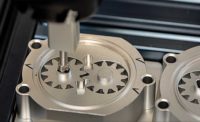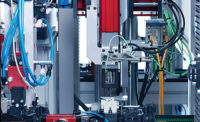In a perfect world, we would not worry about manufacturing variables. Parts would never be too big or too small, too hard or too soft, too long or too short, or too thick or too thin. Our assemblies would work exactly as required. Alas, we don't live in a perfect world, and the parts we deal with on a daily basis have all of those variations-and more.
One answer to this ever-present problem is to specify smaller tolerances for every component, but that carries an inevitable cost penalty. Another answer is to inspect and test every component and assembly, weeding out those that don't meet the required specifications. This approach also carries a cost penalty.
There is a third alternative, but making it work requires changing the way you view assembly processes and your definition of quality. All products are produced to provide a function. How well and how reliably they perform this function is the best measure of quality. If the assembly process compensates for component variability, the assembled product will function to an optimum level of quality regardless of variations in its constituent parts.
A Pressing Issue
Historically, assembly presses have been designed to push until mechanically stopped, with no regard to other parameters. Often, the presses are sized to the maximum load required for the worst-case scenario. The press then applies the maximum load to every part. This can be detrimental to the quality of the assembly.
A common example is pressing studs into wheel hubs. The actual force required to seat a stud varies from hole to hole and from hub to hub; the required force typically varies over a range of thousands of pounds. Standard practice is to press the studs to a shoulder using a hydraulic cylinder, applying the maximum force to every stud. If it takes between 6,000 pounds and 12,000 pounds to press any particular stud to its shoulder on a particular model wheel hub, then every stud is hit with 12,000 pounds. This technique seats every stud, but it can also deform the wheel hub, which has a very stringent specification for flatness. With each 12,000-pound hit, the probability of producing an out-of-specification wheel hub assembly increases.
One effective answer to this kind of dilemma is to close the loop, measuring the applied force in real time and adjusting the applied force in proportion to need. Closing the loop in this manner can be accomplished by an electromechanical assembly press that is equipped with a built-in load cell and control system that can acquire and react in real time to data from external sensors. The control system monitors the force curve and applies only the amount of force required to seat each individual stud. This seats every stud to its shoulder, and minimizes deformation of the hub.
Adjust to Function
Another common example is rivet forming. In one particular case, a manufacturer was assembling automotive hood latches using conventional hydraulic press riveting. The latch components and the rivet were placed in a fixture and the press ram applied force to head the rivet until it reached a mechanical stop.
The fundamental problem is that rivets are far from precision products; their hardness, diameter and length vary widely. The stamped components of the hood latch also vary. In fact, variations in component properties, such as hardness, are a given in manufacturing. As long as manufacturers have variations in component properties from batch to batch, and different manufacturing methods, they will produce variant products. Rivet hardness is no exception. The variations we allow in diameter, length, roundness and hardness begin the process leading to variations in the assembled product. Let's take that rivet to its final resting place-a hood latch. If the latches are assembled with a variable process-like pressing a rivet to a mechanical stop-the results will be variable.
In this case, the results were so variable that the manufacturer had several employees wiggling the latch assemblies to weed out the inoperable ones and to wear in those that were stiff, but salvageable. This is the "inspect and test every component and assembly" answer to the imperfect world and, needless to say, the process was costly. Rejects were high, and product performance was inconsistent, which created dissatisfaction among vehicle buyers.
The first step toward optimizing this process is to control press motion in real time by closing the loop in position. Instead of running against a mechanical stop, the electromechanical assembly press with its built-in load cell moves the ram until it feels the top of the rivet. The ram then continues to move from that "touch point." The distance the ram moves after the touch point is determined by a measurement taken by an external probe, built into the tooling, that essentially measures the thickness of the stamped component and feeds this dimension back to the controller. Thus, the process self-compensates for variations in both the rivet and latch.
The next step is then to ensure, while it is being assembled, that the product will function by closing the loop in applied force. A motorized torque control device pivots the latch assembly while the rivet is being formed, measures the torque required to pivot the latch, and feeds that data back to the controller. This functional data about the latch is used to control the force applied by the press, forming the rivet until the correct latch torque is achieved. Thus, the latch manufacturer can assemble to a functional tolerance, certify the exact resistance in the latch movement and establish a precise functionality standard, all independent of variations in the component parts. In the end, the latch manufacturer gets a streamlined assembly operation with less scrap and less labor. The original equipment manufacturer gets latch assemblies that meet defined performance standards at reduced costs. And the vehicle owner gets a hood latch that works consistently for the life of the vehicle.
Adjust to Spec
The same principle can be applied in assembling products that require adjustment during assembly to meet performance specifications. Hydraulic pressure-relief valves are a good example. A relief valve is spring-actuated, so the opening pressure is determined by spring length and stiffness, both of which vary from batch to batch.
In one case, a manufacturer had produced valves rated at an opening pressure of 1,000 ± 200 psi for many years, with a scrap rate of approximately 6 percent during functional testing. Then a major customer requested valves with half that variation in opening pressure. The manufacturer calculated that meeting this requirement would increase the scrap rate to 17 percent unless more expensive springs were used. Of course, that would raise production costs, and the customer was not willing to pay extra for valves with the tighter specification on opening pressure.
Rather than focus on component consistency, the manufacturer decided to assemble the check valves according to a performance standard rather than a mechanical or dimensional standard. The manufacturer turned to a closed-loop assembly process using an electromechanical assembly press equipped with end-of-ram tooling to press the valve seat into the valve body while fluid is flowing through it at a fixed rate.
Fluid pressure is measured and fed back to the controller in real time, as the valve seat is pressed into place. When the specified pressure is reached, the press ram is stopped and the assembly operation is finished. The resulting valves consistently provide a ±2-psi variance in operation. The closed-loop assembly process produces virtually no scrap, and allowed the manufacturer to eliminate a gauging station and produce valves at lower overall cost.
Attaining Positive Results
Positive results are common when manufacturers adopt technologies that allow the assembly process to adapt to component variables rather than trying to control every variable down to the last micron. In applications where products are assembled by pressing one or more components together, the heart of this adaptive control approach is a measure-and-press, press-and-measure philosophy.
Measuring critical part parameters or functions during the assembly process, and then using this information in a closed-loop system to control the assembly process, is the key to manufacturing better products at lower cost. Instead of producing the component parts to increasingly tighter tolerances and then assembling to fixed dimensions by pressing to dead stops or bottoming out in the part, the assembly process should compensate for the variations in the component parts.
The Good. In the end, producing a more consistent and reliable product at a lower cost is the main benefit of using the closed-loop control capabilities presently available. This is accomplished by taking advantage of available technologies to design more adaptive assembly processes. State-of-the-art control systems provide advanced monitoring and data acquisition capabilities, good documentation and help with process troubleshooting. These attributes enable manufacturers to achieve superior results when coupled with today's energy-efficient and environmentally friendly press technologies. For example, the capability to certify subassembly and finished product quality in the assembly station can eliminate downstream test stations.
The Bad. In many cases, these advantages do come at higher upfront costs. These higher costs are usually recovered during the first year due to lower maintenance and energy cost, and more machine uptime. Very often, the upfront cost is immediately offset by eliminating a test station or a less costly startup.
Another concern is that adaptive control technology requires a higher level of technical competence to support and maintain the system. Calculating the distance a press ram should move to form a rivet by measuring the latch thickness and rivet height is more complex than hammering the rivet with a hydraulic cylinder.
The Ugly. Innovative companies are driving the change from brute force assembly operations toward more controlled and adaptive processes. However, many machine integrators still adhere to the "do it as we always have" mentality. The world of "target pricing" is also responsible for some of the reluctance to embrace new methods. Integrators tend to offer equipment with the lowest upfront cost rather than what is best in the long-term.
You always hear the phrase "we must work smarter not harder" applied to employees. This phrase must also apply to your assembly process if you are going to be competitive. Assembly technology exists today, as a standard off-the-shelf product, to add adaptive assembly control to press applications.




